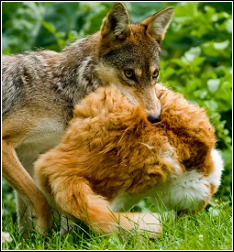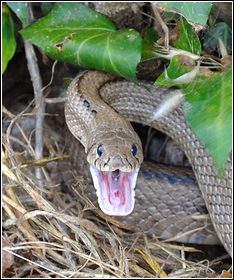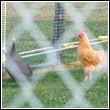Farm & Pet Safety
Keeping Wildlife Under Control
Taking steps to keep wildlife under control around your property, is a great place to start when it comes to protecting pets from wildlife.
Barriers, low voltage wires, deterrents, and even something as simple as mowing, can go a long way when it comes to keeping the environment around your home a safe place for your domestic animals to thrive.
Fences And Containment
Containing your pets and livestock is always a must. There is a side benefit to the fencing and barriers you use to keep domestic animals in - they also help keep unwanted nuisance wildlife out. Underground barriers such as Dig Defence help keep your dogs from escaping by digging under the fence, but they also keep wildlife such as bobcats, skunks, armadillos, opossums, rabbits and porcupines from digging under to come inside. At the very least, underground barriers reduce the number of places that nuisance wildlife has access to in order to create burrows and dens. Wildlife wants three things - food, water, and shelter - if they can't find shelter or anyplace to create it, they will likely move on.

Low voltage or "hot wire" is often used around homes and farms to keep animals away from fencing and/or to discourage them from jumping or climbing over the property line. This also works well when it comes to keeping wildlife out, it is not fool proof, but it can help serve as just one more deterrent to encourage troublesome wildlife to move on to other areas where the job at hand will be much easier to accomplish.

Fencing in itself can be helpful too, locking your chickens or small livestock up at night, in an enclosure designed for keeping coyotes, bobcats and other predators out can certainly help cut back on losses.
In many instances, it will be as important to protect your smaller animals from predators that swoop in from above as it is from those that approach at ground level. Hawks have been known to pick up toy breed dogs and owls are often the source behind smaller cats and dogs disappearing while spending time outside. In such cases, a fence by itself may not be enough and your enclosure will need protection at the top of it too.
Reducing Temptations
If you are feeding your pets outside, area wildlife will catch on to this quickly and take advantage of the opportunity for a free meal.

Invading wildlife may find your pet a threat to their new found food source and become aggressive or protective. We've encountered a few homeowners that find it amusing their pets are co-existing with wildlife, but what they don't realize is that wildlife can also bring with them disease and parasites that can be harmful to your pet. The photo below was taken of a cat in its feeding location - not only had the food attracted a opossum, but if you look closely you will see that it has attracted a skunk too!

Home And Landscape Maintenance
There are three lines of defense when it comes to making your property less attractive to wildlife; one, exclude wildlife from your home or main building by making the necessary modifications to ensure that there are no entry points, two, exclude wildlife from utilizing your foundation, sheds, or outbuildings as places to live (deter them from digging burrows, nests and dens), and three, make your landscaping less appealing.
By addressing these three areas of your property you will be taking away one of the main things wildlife is looking for - shelter. If you don't address these three areas of your property wildlife will move in. It may start with smaller wildlife such as mice or squirrels, but smaller wildlife will attract larger animals such as raccoons and snakes. The more wildlife you have on your property the more likely it is your pet or other domestic animals will come in contact with them resulting in your pet becoming injured, contracting a disease, or even worse, becoming their prey.

Taking away opportunities for wildlife to turn your property into a home, or permanent source of shelter, is a must, but if you have pets, children or livestock you will need to take things a step further and eliminate any opportunities for camouflage or concealment too.
Rats, mice, snakes and many other kinds of wildlife utilize grass, foliage, and trees for camouflage or concealment. If you don't keep your grass mowed and landscaping under control, your property will become a tempting environment for wildlife to hide and hunt.

Some wildlife utilizing the opportunities brought about by high grass and plentiful foliage, will be hunting for smaller animals such as mice, but larger wildlife may take advantage of it too - wildlife such as coyotes, bobcats and mountain lions that see your actual pets as prey. Don't be fooled into thinking that your pets are safe because you live in the city, foxes, coyotes, bobcats and other wildlife have learned to adapt to suburban lifestyles and can often be spotted right in the middle of town.

The more a wild animal's presence can be concealed around your home the more likely they are to take advantage of it to get closer to your pets.
Livestock Guardians And Other Working Domestic Animals
Keeping a livestock guardian on site can be great deterrent to wildlife and a great step toward protecting your domestic animals. One of the first guardians that comes to mind for most is a dog, particularly one that is bred with that specific purpose in mind. Some sheep dogs are bred to herd, whereas others, such as the Great Pyrenees, are bred strictly to ward off predators. The dog seen in the photo below was a Great Pyrenees owned by one of our clients. Dusty, as she was known, faithfully kept the acreage coyote free for over 12 years. She would even chase off visiting owls in order to help protect the younger barn cats.

The task of livestock guardian is not limited to dogs however, other animals such as llamas and donkeys can do an incredible job too. A good guardian donkey isn't afraid of much and will gladly harass foxes, coyotes and bobcats until they get tired of it, take off and head for easier pickings.

It is important to note however, that individually speaking, some livestock guardians will do a better job than others. Dusty, the dog in the above photo, was very focused on her task at hand - periodically patrolling the fence line and positioning herself in locations where she could see both the livestock and any approaching predators. Dusty's companion however, another Great Pyrenees, was more interested in chasing butterflies than she was patrolling the fence line. The guardian skills of individual Donkeys and llamas can vary as well, some will be harder working, braver and kinder to livestock than others. You will want to be careful to choose a guardian that won't chase, harass or be too rough with your livestock or pets. This will be something you will want to watch particularly close when bringing a new donkey or llama home.
Technically speaking, a working barn cat may not necessarily be considered a "guardian" ready to do battle against treacherous wildlife in search of prey, but they do have an important secondary role when it comes to reducing the number of wild animals invading your property.

Cats will catch and eat mice, rats and birds, all of which would otherwise attract menacing wildlife such as snakes, coyotes, bobcats, opossums, foxes and raccoons. To learn more about working cats, please visit our section on the Trap, Neuter & Return program which helps make working barn cats available without uncontrolled population concerns.
Wildlife Control Methods Hazardous To Pets
Protecting pets and livestock isn't simply a matter of controlling wildlife around your property - it's also about how. Poisons and traps are among some of the first things people typically reach for to solve their wildlife problems. However, pets can inadvertently get caught in traps, or eat the poison themselves, or inadvertently be killed by secondary poisoning.

When targeted wildlife eats poison, that poison will be in their system, if your pet or livestock discovers and eats the affected animal (be it dead or alive), they too will then have the poison in their system - just as if they had eaten it themselves. In other words, simply placing the poison in an area where your pet can't reach it, won't protect your pet from being poisoned.
If you have neighbors close by that are utilizing poison to control rats, mice or other wildlife you may want to visit with them regarding safer alternative methods that won't pose a danger to your pets or theirs.
1242 SW Pine Island Rd., Suite 310
Cape Coral, Florida 33991-2126
help@totalwildlifecontrol.com




















